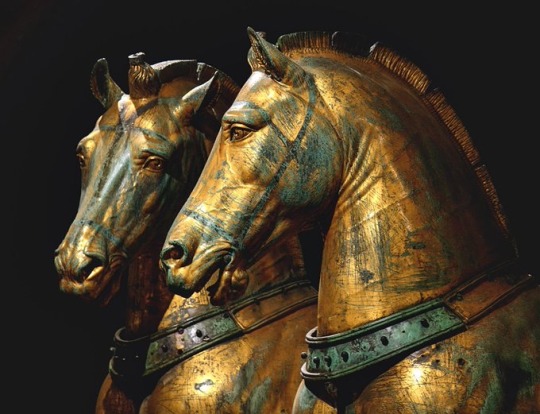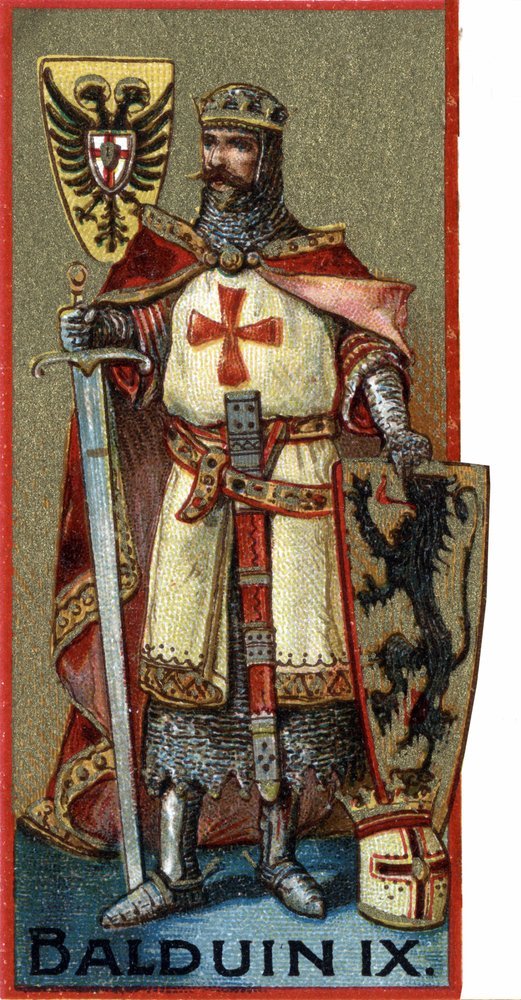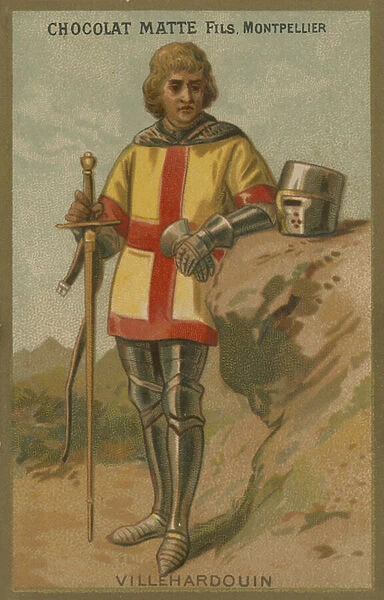#Fourth Crusade
Explore tagged Tumblr posts
Text




Triumphal quadriga, taken from the Hippodrome during the sack of Constantinople, 1204. Now located inside St. Mark’s Basilica in Venice
#fourth crusade#aka the robber���s crusade#i was going to say the murder crusade but that’s kinda all of them isn’t it?#byzantine#constantinople#roman art#byzantine art#these horses are virgos#rome#statue#bronze statue#cast bronze#but really dirty copper
131 notes
·
View notes
Text

Portrait of Baldwin IX, Emperor of Constantinople from 1204 to 1205.
He was defeated at the Battle of Adrianople by Kaloyan, the emperor of Bulgaria, and spent his last days as a prisoner.
Twenty years later, in 1225, a man appeared in Flanders claiming to be the presumed dead Baldwin. His claim soon became entangled in a series of rebellions and revolts in Flanders against the rule of Baldwin's daughter Jeanne. A number of people who had known Baldwin before the crusade rejected his claim, but he nonetheless attracted many followers from the ranks of the peasantry. Eventually unmasked as a Burgundian serf named Bertrand of Ray, the false Baldwin was executed in 1226.
#latin empire#crusades#bladwin I#latin emperor#crusader#outremer#Emperor and Autocrat of the Romans#fourth crusade#byzantine empire#baldwin IX#count of flanders#full length portrait#baldwin vi#count of hainaut#full-length portrait#in armour#Battle of Adrianople#latin emperor of constantinople#middle ages#county of flanders#kingdom of belgium#comté de flandre#royalty
9 notes
·
View notes
Text

Attack of the Crusaders on Constantinople, from manuscript of La Conquête de Constantinople by Geoffreoy de Villehardouin kept in the Bodleian Library
Source
42 notes
·
View notes
Text

Constantinople was the centre of the world. Even as late as the 11th Century, which is the time frame this image depicts, it was still the most important city on Earth despite its diminished prestige and domains.
The Komenian Restoration would provide a brief ray of light after the Seljuk conquest of Anatolia before the lights were ultimately snuffed out, first by the Fourth Crusade in 1204 and then by the Ottomansfor good in 1453.
#constantinople#ottomans#fourth crusade#history#byzantine#byzantine history#roman history#11th century
3 notes
·
View notes
Text
Is
Is this
is this a reference to the Fourth Crusade, the other time white Christians famously “accidentally” attacked Greeks (who were also Christian) while intending to stop a spate of persecution in the Levant

i,,,,,,,,,,, ?????? like?????? where to even begin?????
1. the greek flag literally has a fucking cross on it.
2. the fact their first reaction to seeing blue and white flags was to start recording themself ripping them down and screaming at the workers.
3. “this is nothing against people who are jewish” weird how no one mentioned jews except u, the person that just ripped down a bunch of greek flags while screaming about israel.
4. why the absolute fuck would you post a video like this of yourself that was such a public embarrassment????
genuinely this is what makes me so furious and terrified about so many american “activists” bc this is not the only public display of ignorant indignation i’ve had the displeasure of witnessing or experiencing this year, both online and in person. they’re not in it to advocate for palestinians. they’re in it for the cathartic fury, feeling like a hero, getting to tell people off and feel morally superior. getting to be more open about their jew hatred is a bonus.
#Fourth crusade#Frankokratia#Partito terrarum imperii romaniae#Pope innocent III#Venice I haven’t forgotten what you did
1K notes
·
View notes
Text

The Swan Song - by Portable Frailty
Inspired by events said to have transpired after the armies of the Fourth Crusade sacked Constantinople in 1204, In one of the most shameful episodes of European history, soldiers of the conquering Latin armies are said to have ensconced a drunken prostitute on the Patriarch's throne in the Hagia Sophia. There, according to legend she either held a mock mass or gave a drunken song and dance routine. The Venetians who took part in the sack, themselves historic and cultural heirs of the Byzantines, are said to have behaved better but did not refrain from looting Constantinople's cultural, religious and artistic heritage (much of which remains in the treasury of St. Mark's Basilica to this day).
I came across the story of the 4th Crusade when I lived in Istanbul for three years. Like anyone, I was always awed by the magnificence of surviving Byzantine treasures like Hagia Sophia despite the ravages of the 1204 sack. Nevertheless, I took personally the desecration visited on my adopted city--I still do. The treachery of fellow-Christians in the 1200s broke Byzantine power and made inevitable the Turkish sack in 1453 (which was far more restrained by comparison).
Thus, in this image I have sought to popularize and capture the spirit of this unjust defilement--a warning that no treasure of human making, no matter how beautiful or revered, is safe when people abandon wisdom and restraint for greed, malice and ignorance.
#4th crusade#Fourth Crusade#the crusades#Byzantine Empire#1204#Constantinople#Medieval History#Venetians#Venice#Istanbul#1453#Byantium
0 notes
Text
The church of San Marco in Venice, Italy holds a treasure trove of artworks and other objects made of precious materials and lavishly decorated with gems, pearls, and enamels. But while many of these objects have sat in San Marco for centuries, not all of them originally come from Venice or even Italy, as their Greek inscriptions suggest. Instead, several objects in the treasury of San Marco were produced in the Eastern Roman “Byzantine” Empire, whose capital was Constantinople (modern Istanbul). How did they get to Venice?
In 1204, Venetians were among the crusaders of the Fourth Crusade who sacked Constantinople and looted its great palaces and churches. The crusaders melted down many objects of precious metals that could be easily converted into money. But they also brought home objects and donated them to churches like San Marco. Such objects were likely preserved because of their precious materials, artistic beauty, and sacred functions, as well as the fact that many were made of materials like stone or glass that could not be melted down and converted into money. In their new settings, some objects continued to be used for their original functions, while other objects were repurposed for new uses. Such works illustrate how portable objects could move between cultures and be reused in the medieval world.
Perhaps surprisingly, some of the Eastern Roman (Byzantine) objects in the treasury of San Marco were themselves products of reuse of even older objects from the ancient world. Consider the example of two tenth-century chalices—one with handles and one without—which bear inscriptions that refer to an Eastern Roman emperor named Romanos (either Romanos I Lekapenos, or Romanos II). The Romanos chalice with handles combines a sardonyx stone bowl with delicately carved handles and a silver gilt setting. It is decorated with precious stones and colorfulicons of Christ, angels, and saints. An enamel inscription beneath the bowl of the chalice reads: “Lord help Romanos, the Orthodox ruler.”
The Romanos chalice without handles similarly combines a sardonyx stone bowl with a silver gilt setting and is decorated with enamels and pearls. The same inscription referring to Romanos appears around the base of the chalice, telling us that this vessel must have been produced for the same emperor Romanos.
In Constantinople, these opulent objects were once used in the celebration of the Eucharist, in which bread and wine were offered to God, then consumed by worshippers as the body and blood of Christ. It is easy to imagine the worshippers' awe as they approached these shining vessels, which mediated their encounter with Christ. Catching a glimpse of the inscriptions on these vessels, worshippers might have spoken the inscribed prayer on behalf of the emperor.
The stone bowls of both chalices were ornately carved by highly skilled artisans. Although they are difficult to date with precision, art historians believe that they were not fashioned in the tenth century when the chalices were made. More likely, they were produced in antiquity, centuries earlier. Although the stone bowls were not originally intended for Christian chalices, the emperor Romanos (I or II) likely commissioned artisans to transform these stone bowls into chalices because of their exquisite craftsmanship and because their red hues and swirling textures evoked the wine of the Eucharist, believed to be the blood of Christ.

Chalice of Emperor Romanos, Byzantine, 10th century
#studyblr#history#military history#religion#christianity#eastern orthodox church#islam#trade#commerce#art#art history#carving#crusades#fourth crusade#italy#veneto#byzantine empire#venice#constantinople#istanbul#st mark's basilica#romanos i lekapenos#romanos ii#chalices#chalcedony#sardonyx#communion#eucharist
842 notes
·
View notes
Note
Actually in other universes, the changelings were reformed by giving away love, and as a result, they don't feed on love anymore. Everyone except for Queen Chrysalis were reformed.



“How long’s it been now? A hundred years or so? Can’t see these varmint ever changin’ their ways. Reckon maybe my world’s just plain cursed... Like Granny Smith used t’ say, 'Some trees just don’t bear no sweet fruit'.”
#apple bloom#ask the last crusader#ask hivebuster bloom#kirya#queen chrysalis#matriarch chrysalis#fourth generation of changelings#mlp ask blog#mlp art#mlp fim#mlp g4#my little pony#ask me anything#mlp au#hivebuster au#pony#changeling
37 notes
·
View notes
Text
omg Cacophony???

#i NEVER see him in anything. love him......#interesting interpretation of his verbal tic thing#in the comic he gently taps the fourth wall and repeats or replaces the actual comic onomatopoeias#batman#batman caped crusader
8 notes
·
View notes
Text

Geoffrey of Villehardouin (1150–1213) was a French knight and historian who participated in and chronicled the Fourth Crusade. He is considered one of the most important historians of the time period.
#crusades#geoffrey I of villehardouin#fourth crusade#holy land#latin empire#villehardouin#prince of achaea#peloponnese#county of champagne#full length portrait#in armour#full-length portrait#Conquest of Constantinople#Marshal of Champagne#byzantine empire#Battle of Adrianople#kingdom of heaven#steven runciman#chocolate card
4 notes
·
View notes
Text
I'M SCREAMING
The historical context here is that Pope Innocent III really felt that previous crusades had messed up and gone astray because they didn't have a STRONG POPE telling them what to do! So he decided to call for a Crusade that would be uniquely accountable to, and controlled by, Himself, The Man of the Hour.
Except that the 4th Crusade went astray harder and faster than any crusade before it, took a detour to the still-officially-an-ally Byzantine Empire at Constantinople, sacked and conquered the place, and set up a short-lived and unstable Latin regime which severely weakened one of the primary political entities protecting the Christians of the Levant. The fourth crusade never even made it to the Holy land.
You really showed 'em, Innocent.

#history#the crusades#medieval history#medieval#history memes#Fourth Crusade#Snowy is obviously the rump crusader state at Acre watching as their military aid package gets catastrophically diverted
674 notes
·
View notes
Text

#the first thing my husband sent me this morning#and the answer is 'because enrico dandolo is cool fuck u'#the fourth crusade is such a sad time for me#my two favorite medieval powers fighting :(
17 notes
·
View notes
Text










#the rd crusaders#hold your head up#charity concert#2003#russ ballard#richard desmond#simon townshend#greg lake#aitch mcrobbie#sam brown#margo buchanan#steve smith#aaaaaaaaaaaaaaa aajhgsdjhgjsdg he is getting the crowd to sing along#in the third one he pointed out at them and said 'I LIKE IT' before singing hold your head up again#his face in the fourth one listening to them sing#he's so precious please i love the way he gives the audience just as much of his attention as they give him#he really always makes it feel like he's there not just to perform but also to hang out with them like#like they're all just a large group of friends#that's always the vibe with him#his BOING#HIS BOING HIS BOING HIS BOING#THE ONE LITTLE HOP#help i'm laughign at the last one#I LOVE HIM
4 notes
·
View notes
Text

#history memes#meme#funny#the fourth crusade#crusaders#the crusades#medieval history#medieval#turkey#byzantines#the Byzantines#byzantine empire
5 notes
·
View notes
Text
Geoffrey of Monmouth is so funny. He's a proud Briton, and that comes through in his portrayal of the Anglo-Saxons. But the Anglo-Saxons get to be cool villians, they're cruel and cunning, but can be brave and do sometimes win battles.
This is in stark contrast to the Romans. I don't think he ever lets the Romans win a battle over the Britons. They show up in Britain, immediately get absolutely slaughtered and then somehow end up in control over the island anyway with no explanation. This happens about three or four times.
I cannot get over how funny this is. He was around in the 12th century. The Roman empire still existed then, but post Manzikert they were hardly doing much to threaten Wales. Where the hell did he get this hatred from?
#geoffrey of monmouth#History of the kings of britain#He's so funny#Literally thinks about rome everyday and seethes#RIP geoffrey you would have loved the fourth crusade#Or mehmed the conqueror#I want to put him in a room with anna komnene
8 notes
·
View notes
Text
Before this day is over
HAPPY FOURTH OF JULY TO THE Philippines!!!!🇵🇭🇵🇭🇵🇭🇵🇭🇵🇭🇵🇭
They gained their independence from the US on this day in 1946
Also in this day in history Palestinians successfully expelled the Crusaders in 1187
#philipines#Filipino independence. from US#philippines independence day#palestine#crusades#fourth of july
1 note
·
View note